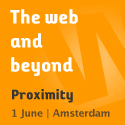As you may have seen from
a previous post, I am reading Stewart Brand's "How Buildings Learn: What happens after they're built". This time, my eye fell on this paragraph (on page 71 of my edition) where I couldn't help but read "information architecture" wherever it read "architecture", so I changed that for you:
"One of the things which we are searching for is a form of [information] architecture which, unlike classical [information] architecture, is not perfect and finite upon completion... We are looking for an [information] architecture rather like some music and poetry which can actually be changed by the users, an [information] architecture of improvisation."
The next paragraph ends with the question:
"What would an aesthetic based on the inevitability of transience actually look like?"
In my view,
this is yet another description of the ancient Japanese philosophy called wabi-sabi.
I already used some of that philisophy's ideas in a proposal for a user experience design approach for Web2.0 (in the shape of my
poster for Design Engaged) and this quote gives me confidence that it can also be applied in
the fields underlying User Experience. I guess it is time to re-examine that poster and see how it applies to information architecture.
 When I was in Berlin for Design Engaged I had a couple of hours to discover Berlin (plus the evening strolls with the other participants) and this time I will not have many more. Still, there is one thing I want to see: The Holocaust Memorial. Hopefully it will show up in my Flickr stream...
When I was in Berlin for Design Engaged I had a couple of hours to discover Berlin (plus the evening strolls with the other participants) and this time I will not have many more. Still, there is one thing I want to see: The Holocaust Memorial. Hopefully it will show up in my Flickr stream...









